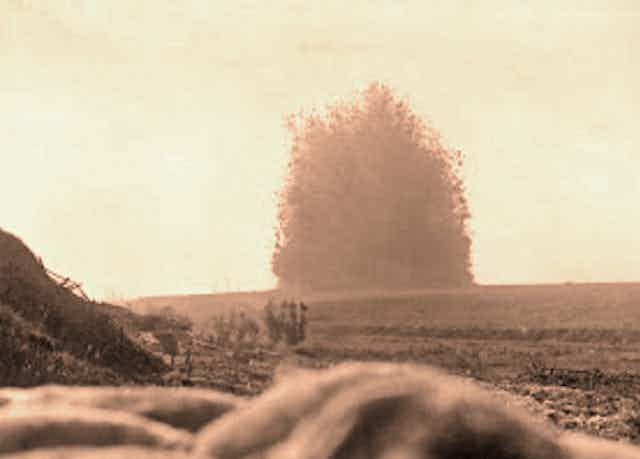The Battle of the Somme began on July 1 1916 with a spectacular explosion under Hawthorn Ridge – a fortified German frontline position west of the village of Beaumont Hamel in northern France. The footage of the explosion remains one of the best-known pieces of film from the whole conflict.
Almost 60ft below the surface, British miners of the 252 Tunnelling Company had hand dug a gallery for more than 900 metres through chalk and packed it with 40,000lbs of ammonal explosives. It was one of 19 mines placed beneath German front positions that were detonated on July 1 1916, to mark the start of the offensive.

But the mine detonation at Hawthorn Ridge, famously captured by military film director Geoffrey Malins, took place ten minutes before the whistles blew at 7.30am. This controversial decision was made in order to protect the attacking British troops from falling debris.
But disastrously, it allowed the Germans to take the crater and repel their advance, leading to massive losses among the attacking British troops from the 29th infantry division.
Malins recorded his feelings after the event in the film The Battle of the Somme, released later that summer:
The ground where I stood gave a mighty convulsion, it rocked and swayed … the earth rose in the air to the height of hundreds of feet. Higher and higher it rose, and with a horrible, grinding roar the earth fell back upon itself, leaving in its place a mountain of smoke.
Bringing science to bear on history
Now, the first scientific study to be carried out at the 107-year-old crater has just been published and has unearthed new details on its history. Our team of researchers, which comprised the authors listed here – scientists from Keele and Staffordshire universities supported by a historian from Goldsmiths, University of London – used a range of cutting–edge technology to examine the site as it has never been seen before.
Surveys of the surface examined the crater in detail never before seen at this site. It revealed shell holes clustered to the east of the crater that had been created by British artillery in their attempts to dislodge the Germans from their crater stronghold.
Other technical surveys greatly enhanced our knowledge of this internationally significant site. Over two field seasons in 2018 and 2019 we carried out magnetic and electrical resistivity geophysical surveys, to identify promising areas for subsequent archaeological excavations.
While, due to the variable topographic conditions and the inevitably metallic debris of the battlefield, these surveys were difficult to carry out, they were incredibly valuable, as they pointed the way for fruitful excavations.
Read more: Explainer: how do archaeologists discover forgotten ancient monuments?
Carried out in the third field season in 2020, these archaeological excavations uncovered hard evidence of the stubborn German defence on that fateful first day on the Somme. Though the early detonation led to the loss of many Württemberg infantrymen of the German 119th Reserve Infantry Regiment, our work uncovered hard evidence of how the newly formed crater was turned to their advantage.
![archaeologist pointing at a small section of recently excavated [German] barbed wire at the north-west side of the crater. Modern sandbags are present to stop soil from falling back into excavated areas](https://images.theconversation.com/files/568227/original/file-20240108-17-f83q9f.jpg?ixlib=rb-1.1.0&q=45&auto=format&w=237&fit=clip)
It revealed the still-intact German defensive fire-pits, barbed wire and other materials showing how the Germans quickly built the crater as a new defensive position into their frontline, meaning the chance for the British breakthrough in the early days of the Somme was lost.
An unmanned aerial vehicle (drone) survey – a now common way to map scientific areas of interest – also uncovered evidence of a previously unknown “sap” or shallow tunnel, most probably dug by the Germans after they had captured the crater, probing towards the British lines, again showing their mastery of no man’s land after the initial detonation.
If at first you don’t succeed…
As the battle dragged on towards winter, a second attempt to capture this new position was tried, and this time, was more successful. A second mine was laid using 30,000lbs of ammonal explosive, and was blown from the same tunnel on November 13 1916.
With no delay this time, and with better planning, the mine was much more effective, aiding the 51st Highland Division to capture Hawthorn ridge and the nearby village.
Our surface surveys mapped out this second crater, merging as it does with the original in today’s landscape. This time, archaeological surveys discovered an empty ammunition box for a Vickers machine gun within the crater, reflecting the period of British occupation of the site.

Our study has provided rarely undertaken scientific investigations of a mine crater, and of the strongpoint the Germans built in no man’s land that doomed the initial British attack to failure.
Our results reinforce the notion that blowing the mine ten minutes early was a very bad idea. While it was intended to protect the attackers from falling debris, it gave the Germans time to capture a valuable strongpoint, ripe for fortification.
It was only with concerted effort four months later, and the second mine and subsequent detonation on November 13, that the Hawthorn redoubt was finally captured by the 51st Highlanders, marking the end of the battle some five days later. This time the mine was exploded immediately before the ground assault began – the early detonation of the July 1 was not repeated.
It was a lesson learned the hard way. More than 3 million men fought in the Battle of the Somme, a million of whom were killed or injured, making it one of the deadliest battles in human history.

